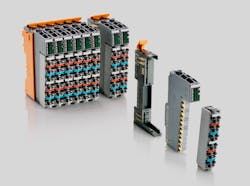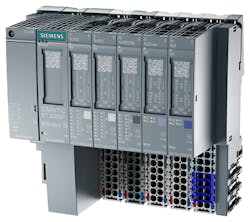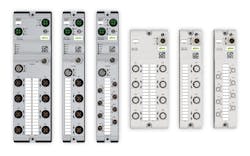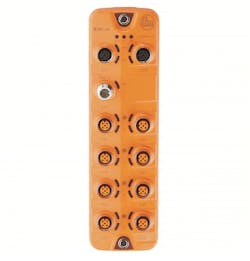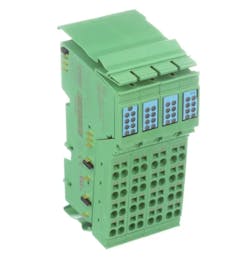Inputs and outputs (I/O) are fundamental to the world of computing, industrial control and data/information processing. Without them, industrial and electronic devices of all kinds would have no way of receiving data, and the user would have no way of manipulating or interacting with the data sources. Since they form the basis of our relationship with almost all the industrial devices we use, it’s important to understand how I/O modules function.
As a key component of industrial systems, I/O modules ensure connectivity and control of systems, processes and devices. They usually include analog channels, digital channels or a combination of both. Analog inputs can detect various signals including frequency, voltage or current. Digital I/O are used for low-level on/off signals. I/O modules that have analog inputs and digital outputs often incorporate an analog-to-digital (A to D) converter to process the signal.
Essentially, I/O modules act as mediators between a central processor and the industrial device. For example, the input modules on a programmable logic controller (PLC) receive signals from switches, sensors, transmitters, actuators and other equipment connected to it. The output modules on the PLC send response signals to the devices controlled by the PLC in response to the received signals.
Common functions enabled by I/O include:
- Device communication:An I/O module can perform multiple device communication functions, such as status reporting, sending/receiving commands and information transfer.
- Control and timing:To properly manage the flow of information between a computer or industrial system and an external device, an I/O module uses a processor’s internal resources to perform time management.
- Processor communication:Completing processor communication requires an I/O module to carry out such tasks as decoding and accepting commands and recognizing its own address on the network.
- Error detection:An I/O module can detect an array of problems between the systems to which it is connected, including mechanical errors and data-related issues during transmission.
- Data buffering:One of the most important capabilities of an I/O module is that it can manage the transfer speed between the devices to which it is connected.
Centralized or distributed
A highly centralized I/O system is characterized by concentrated I/O hardware in a single entity, with network or hardwired connections extending from that location. A highly distributed I/O system, on the other hand, has the I/O hardware distributed across many operational and physical areas, with localized network or hard-wired connections extending from these remote locations.
Local I/O is a subsystem typically housed within the same cabinet or rack as the controller. Due to its proximity to the controller, a local I/O wouldn’t have any computing power. Remote I/O, also known as distributed I/O, is usually located away from the main controller.
A distributed I/O architecture incorporates small field devices with a range of I/O options, such as digital and analog channels, temperature measurements and counter inputs. These modular devices provide a flexibility lacking in traditional industrial devices that require a high-density channel count and long cable runs.
The distributed approach allows for short cable runs because the measuring devices are located closer to the sensors. Direct connection of sensors also eliminates the need for signal conditioning. Distributed I/O modules can be integrated into existing communication networks, providing a low cost, flexible upgrade path.
Advanced automation drives I/O demand
Companies of all sizes have begun retrofitting older machines and manufacturing processes with advanced electronics to enable remote monitoring and control. Many have also embraced the use of cloud computing, analytics and artificial intelligence to improve quality, streamline production, detect safety issues and cut costs.
As a result, companies are turning to I/O manufacturers to design smarter, more advanced products that integrate embedded computing technology (typical of distributed I/O). This is a key factor in modern manufacturing operations considering the need for I/O to interface with a growing assortment of sensors for Internet of Things applications. These devices also serve to offload some of the computing duties from the host computer or controller, pushing decision making closer to the edge. This minimizes the latency time from when data is gathered to when a response to that data can be generated, facilitating the near-real-time actions required by smart factories.
Another example of smart I/O is called universal I/O. It enables greater flexibility for I/O changes, most notably from its ability have as many inputs or outputs as needed, thereby bypassing the common I/O module constraint of eight inputs and eight outputs. With a traditional analog I/O system, a lot of upfront work was required to specify the right field I/O module, electrical panels, installation, wiring, power, distribution and networking. Because an I/O system is typically associated with a central controller, extensive programming was often required to get these systems to communicate effectively with each other.
Universal I/O simplifies machine design and system building due to its ability to work with many different PLC environments and fieldbus protocols, thereby reducing or removing the need to replace I/O modules to meet protocol-specific requirements. This I/O technology is also preferred for its ability to work with both new and legacy equipment.
Trends in I/O technology
Though I/O modules don’t often receive the level of attention garnered by controllers and data visualization hardware and software, I/O is the core means of connectivity and interoperability in any industrial automation application—whether its basic inter- or intra-machine communications or as part of the industrial Internet of Things.
Given I/O’s centrality to industrial connectivity, it’s not surprising that both end user and system integrators responding to Automation World’s 2023 survey on industrial I/O use cited the same three recent advances in I/O technology as being the most noteworthy advances. Those three advances are: Ethernet connectivity, multiple protocol handling capabilities and high density/smaller footprint.
End users and integrators agreed that Ethernet connectivity is the number one advance to have been made recently in I/O technology, with the number two spot going to multiple protocol handling and the number three spot to high density/smaller footprint.;
Running close to the number three spot for end users was onboard intelligence (a typical feature of distributed I/O), which ranked just 2 points behind high density. For integrators, however, onboard intelligence ranked fifth in importance, with ruggedization ranking fourth. Interestingly, onboard intelligence ranked seven points lower than ruggedization and 10 points lower than higher density/smaller size among integrators.
I/O type preference
The lower ranking for onboard intelligence in I/O, particularly among our integrator respondents, is reflected in the preference for in-cabinet and remote I/O over distributed I/O, which is known for having onboard computing power as part of a distributed control system (DCS). This preference for in-cabinet and remote I/O in our survey results is also reflective of our respondents’ industries—only 25% of end users and 38% of integrators responding to our survey work in continuous processing industries where DCS use is more common.
As a point of further clarification, just over 50% of end users and integrators cited use of in-cabinet I/O for the bulk (25% to 75%) of their applications and about 45% of end users and integrators use remote I/O in most of their applications. Whereas only about 30% of respondents use distributed I/O for most of the applications.
In an open field response area of the survey for respondents to note other advances they saw as important, end users cited low-power requirements and support for MQTT and OPC UA, while integrators noted IO-Link, automatic identification capabilities and Power over Ethernet.
For those unfamiliar with it, IO-Link is an IEC 61131-9 standardized, point-to-point I/O technology based on the established three-wire sensor and actuator connection. According to the IO-Link Consortium (of which numerous automation technology suppliers are members), IO-Link is not a fieldbus, but a “further development of the existing, tried-and-tested connection technology for sensors and actuators.”
Considering that most respondents work in the discrete and batch/hybrid manufacturing industries, their use of in-cabinet versus remote I/O is a key factor to focus on with regard to industry trends. And it’s clear that remote I/O is a clear winner—with only 28% of end users and 27% of integrators preferring in-cabinet I/O. In contrast, 42% of end users and 37% of integrators prefer remote I/O.
Among end users, the most prominent reasons for their preference include:
In-cabinet I/O
- The wiring between the I/O modules and the PLC is straightforward.
- It’s easier to troubleshoot any wiring or connection issues.
- Standard I/O is associated with simplicity and reliability and are usually designed to be rugged and reliable in harsh industrial environments.
- As system requirements change, additional standard I/O modules can be added or replaced without the need for significant changes to the overall system architecture. This makes it a flexible solution for a wide range of industrial applications.
- Less chance of failure, ease of implementation and no complex maintenance required.
- Less prone to data transmission errors.
- It provides a more efficient and reliable data transfer between devices.
- Its high-speed transmission and low power consumption make it ideal for handling large amounts of data in real-time.
Remote I/O
- Remote I/O solves the cable length cost issue.
- Remote I/O is located nearer to the device it is connected to.
- Process characteristics, such as oil platforms and hazardous areas.
- Dimension vs. space in the cabinet.
- Fewer wires, easier to replace and allows for use of cheaper PLC module.
- Easier to extend.
Distributed I/O
- Flexibility.
- Onboard intelligence.
- Helps reduce electrical cabling.
- Use of AI in onboard intelligence to assist in data handling.
- Scalability.
- Minimizes costs associated with multi-conductor cable installations and unscrambling.
Integrators cited the following reasons for their I/O type preference:
In-cabinet I/O
- Ease of installation and commissioning.
- Most of our systems are designed for a small footprint, so this works well most of the time. When we span an entire floor or multiple floors it is no longer the best answer.
- Easier to keep track of.
- Usually working on older machines, so this approach keeps it consistent.
- One less point of failure.
- Ease of implementation, no complex maintenance required.
Remote I/O
- Reduces wiring and size of control cabinet.
- Less electrical noise susceptibility.
- Ease of installation during machine build.
- Easier to allocate than block style I/O or rack mounted I/O.
- Preference is to distribute I/O and controls near the place where they are used and connect through Ethernet.
- Simplified wiring while still using standard I/O modules.
- Easier to organize what I/O modules correspond to what machinery.
- It helps simplify the overall architecture and reduces signal runs.
Distributed I/O
- Greater flexibility for controls and easy of viewing data.
- In modern industries, the execution of tasks tends towards real-time applications rather than scheduled tasks to improve the productivity. So, monitoring and control is required from far distances for smart factory operations.
- Easier to handle segmentation and re-configuration of the equipment.
- It minimizes cord runs and adds diagnostics I would otherwise not have.
- Networking programmable I/O modules with fieldbus & IO-Link provide flexibility, digital transformation path, modularity, industrial data topologies, and machine learning/artificial intelligence onboard.
- Ability to use C++ allows us to program anything we want, making it more flexible than ladder logic PLC programming which is typical of in-cabinet I/O.
- Better diagnostics. Faster repairment. Less machine downtime.
- Easy to relocate as needed.
End user selection and implementation recommendations
Responses to our survey question asking for their top recommendations to industry peers when it comes to choosing and implementing I/O modules provided a long tail of answers that were often specific to the respondent’s application or industry vertical. However, several common themes were also evident.
For example, many end users respondents advised that I/O module selection should be based primarily on two factors: the technical requirements of the application and the economic cost of the complete system being designed. This latter piece of advice is a good one to keep in mind amid the burgeoning intelligent capabilities deployed at all levels of automation technologies. Be sure to ask yourself if you really need those added features now or potentially in the near term before choosing a more expensive, feature-laden device whose capabilities you may likely never use.
In keeping with this piece of advice, another respondent said to stay focused on factors such as the required number and type of inputs and outputs, the communication protocols supported, and the environmental conditions in which the I/O module will be located.
A somewhat surprising response given the increasing levels of interoperability among automation devices was to “stay within a brand family” when choosing I/O modules. The essence of this point is that, while vendors are offering more interoperable or “universal” I/O devices, some respondents contend that integration and operation is easier and more reliable when using the same brand of I/O and controller. As one respondent noted: “sticking to the PLC's ecosystem is quicker than trying to integrate something foreign to it.”
Other common recommendations included:
- Verify specific protocol support if multiple Ethernet protocols are not built in.
- Interoperability is important but realize that some “standard” interfaces may not be truly interoperable.
- Check DC voltages and ruggedness.
- Ensure compatibility with the equipment to which the I/O will connect.
- Brand reliability makes a real difference.
Integrator selection and implementation recommendations
Reflective of ongoing supply chain issues for critical electronic components as a result of recent chip shortages, one system integrator responding to our survey dispensed with offering specific recommendations and honestly replied that, “at the moment, we prioritize things that are in stock.”
Others were more detailed in their response. One integrator even went so far as to provide the following detailed set of recommendations addressing several factors to ensure selection of the most appropriate I/O for your application:
Compatibility—Ensure that the I/O products you select are compatible with your control system and communication protocol. This will help to ensure smooth integration and reduce the risk of compatibility issues.
Accuracy and precision—Consider the accuracy and precision requirements of your application and choose I/O products that meet or exceed those requirements. This will help ensure that your system operates with high accuracy and reliability.
Signal type and range—Ensure that the I/O products you select support the types and ranges of signals you need to acquire or control. This may include analog or digital signals, high or low voltage signals, and other specialized signal types.
Reliability and ruggedness—Choose I/O products that are designed to operate reliably in your specific industrial environment. This may include products that are designed to withstand extreme temperatures, humidity, vibration or other harsh conditions.
Expandability and flexibility—Consider the scalability and flexibility of the I/O products you select and choose products that can be easily expanded or reconfigured as your system requirements change over time.
Cost—Choose products that offer a good balance of features, performance and value for your specific application. However, be sure not to sacrifice quality or reliability for cost savings, as this can ultimately lead to more expensive problems down the line.
Other frequently noted recommendations by integrators included:
- Always have 25% spare I/O for expansion.
- Wi-Fi access for LAN integration.
- Having the ability to work with any PLC/controller means I can select one I/O family for use plantwide. Only one set of tools to install and learn, only one vendor to deal with and only one set of spares to keep on site.
- Keep a single network type across the design if possible and only implement within a hardened industrial network.
- Choose a brand or two that offers interoperability, diversity of signal types, diagnostic capabilities, ISO 13849 performance level safety capabilities and low voltage power.
- Ensure the I/O you choose is fit for the environment in which it is operating, which ranges from standards considerations such as IP67, IP69K and IP20 to having the right combination of signals and protocol support.
- Determine remote I/O functions by sensor/actuator specifications.
- Reduce I/O long run wiring to ease debugging in the field.
